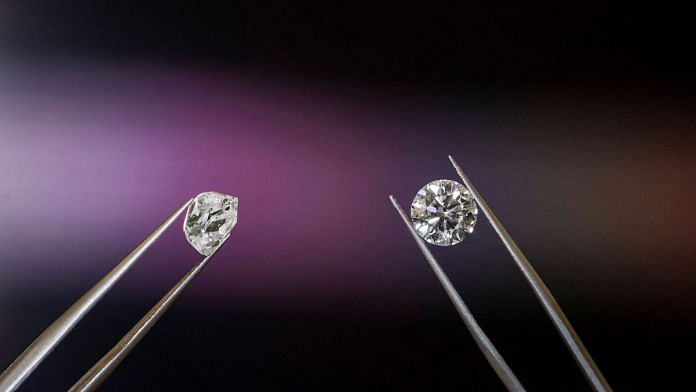New Delhi: A day after finance minister Nirmala Sitharaman announced an allocation of Rs 242 crore for the development of laboratory-grown diamonds in India, The India Centre for Lab Grown Diamonds (InCent-LGD) at the Indian Institute of Technology (IIT), Madras, which has been identified for the process, said the research will be focused on driving indigenisation of the LGD manufacturing process and that the technology will be ready by 2028.
“Lab-grown diamonds (LGD) is a technology and innovation-driven emerging sector with high employment potential. These environment-friendly diamonds have optically and chemically the same properties as natural diamonds. To encourage indigenous production of LGD seeds and machines and to reduce import dependency, a research and development grant will be provided to one of the IITs for five years,” Sitharaman had said in her budget speech.
While India is known for its diamond processing and cutting units, in terms of production, it is still far behind.
“This is indeed the right time to set up a diamond factory in India, given that diamonds have thermal and electrical properties making it superior to contemporary technologies like silicon, silicon carbide and gallium nitride,” professor V. Kamakoti, director, IIT Madras, said in a press statement Thursday.
Kamakoti added: “IIT Madras will work towards producing diamond wafers suitable for electronic applications. It is a historic moment for IIT Madras for being selected for implementation of such an important project, output of which will be a crucial component of Atmanirbhar Bharat.”
InCent-LGD has nearly two decades of work experience in diamond research. M.S. Ramachandra Rao, a professor at IIT Madras’ Department of Physics who will be the principal investigator (he will head the research) for this initiative, told ThePrint that the institute had been in conversation with various ministries for over six months, planning and discussing the LGD initiative.
As the name suggests, lab-grown diamonds are man-made, produced using technology that replicates the natural process which results in the formation of original diamonds. LGDs are chemically, physically, and optically similar to natural diamonds.
Also read: Surat’s new diamond bourse wants Mumbai’s glitter, gets slammed for ‘objectionable’ incentives
Indigenous machine for Indian lab-grown diamonds
Talking about the production process for LGD, Rao said, “ There are two ways of growing diamonds in the lab, one is through the process of chemical vapor deposition (CVD) and the other through the process of high-pressure high temperature (HPHT) technology. Most of the machines required for these processes are either imported or assembled in India.”
The CVD is a newer technique, in which diamonds are grown from a hydrocarbon gas mixture, similar to how diamonds form in interstellar gas clouds. In the HPHT process, carbon is subjected to extreme temperatures and pressures to replicate the extreme heat and pressure conditions deep within the Earth, where natural diamonds are formed, he explained.
For the CVD process, the team at IIT Madras will be creating an indigenous semiconductor microwave generator. “This technology is not readily available across most nations in the world. With India creating an indigenous core machine, we could be the world leaders in this technology” Rao claimed.
According to Rao, a team of over 60 experts from the field of physics, mechanical engineering and electrical engineering departments of IIT Madras will be working to create the semiconductor microwave generator.
Researchers at IIT will also work on creating the recipe and machines for the HPHT process.
India currently has no know-how in HPHT technology to grow and treat diamond crystals, claimed the professor. The cost involved in importing HPHT machines is also very high, he said.
“Naturally occurring diamonds are formed under high pressure under the Earth’s surface, something similar will be created in the lab at IIT Madras,” Rao added.
The professor further said that “in order to do this we need to develop a deep understanding of the core of the machine required for the HPHT process to make sure that the seed crystals are grown into diamonds. While some countries may buy machines, but the recipe to create diamonds is still not known to many. That is what IIT-M will be working on creating.”
In addition to making waves in the diamond sector, Rao claimed LGD has the potential to be highly useful in the textile, pharmaceutical and defence industries.
(Edited by Poulomi Banerjee)
Also read: Diamonds & blood: How sanctions against Russian diamond industry can help crime, hurt India



